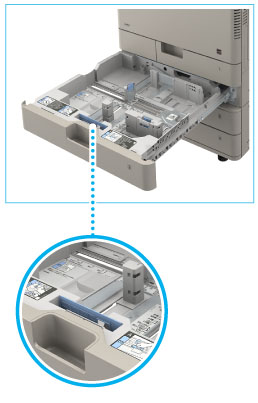Parts and Their Functions
This section provides you with the names and functions of all the parts of the machine.
For more information on optional products, parts, and their functions, see "Optional Products/Software."
External View
When the Cassette Feeding Unit-AL1 is attached:
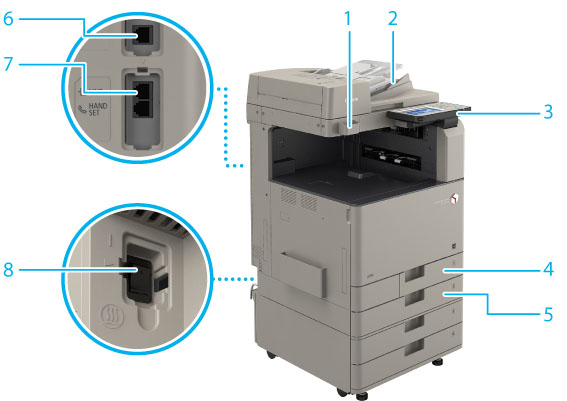
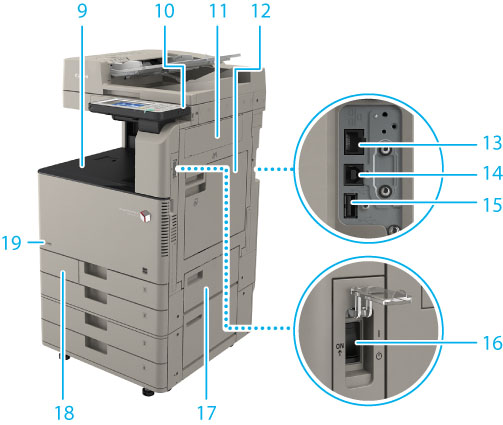
|
1.
|
Glass Cleaning Sheet Storage Box
Use this box to store sheets for cleaning the platen glass.
|
|
2.
|
Feeder
Originals placed in the feeder are automatically fed sheet by sheet to the scanning area. The feeder also automatically turns over two-sided originals to make one- or two-sided copies.
|
|
3.
|
Control Panel
The control panel includes the keys, touch panel display, and indicators required for operating the machine. (See "Control Panel Parts and Functions.")
|
|
4.
|
Paper Drawer 1
Holds up to 550 sheets of paper (80 g/m2).
|
|
5.
|
Paper Drawer 2
Holds up to 550 sheets of paper (80 g/m2).
|
|
6.
|
LINE 2
Use this port to connect the Super G3 2nd Line Fax Board to the machine.
|
|
7.
|
LINE 1
Use this port to connect a fax line to the machine.
|
|
8.
|
Dehumidification Switch
Use this switch when paper in a paper drawer is damp to dry the paper by warming it up, in order to prevent printing problems. Can be used when a heater is attached.
|
|
9.
|
Output Tray
Prints are output to this tray.
|
|
10.
|
USB Port (1)
Use the USB port to connect USB memory, external hard disks, and other devices to the machine.
|
|
11.
|
Right Cover of the Main Unit
Open this cover when clearing a paper jam inside the main unit. (See "Clearing Paper Jams/Staple Jams.")
|
|
12.
|
Multi-Purpose Tray
Use the multi-purpose tray to feed paper manually, and for loading nonstandard paper stock, such as envelopes. (See "Loading Paper into the Multi-Purpose Tray.")
|
|
13.
|
LAN Port
Use an Ethernet cable to connect the machine to a network.
|
|
14.
|
USB Port (2)
Use the USB port to insert a USB cable for connecting to a computer.
|
|
15.
|
USB Port (3)
Use the USB port to connect external hard disks and other devices to the machine.
|
|
16.
|
Main Power Switch
Press to the "I" side to turn ON the machine. (See "Main Power and Energy Saver Key.")
|
|
17.
|
Upper Right Cover of the Paper Drawer
Open this cover when clearing a paper jam. (See "Clearing Paper Jams/Staple Jams.")
|
|
18.
|
Waste Toner Cover
Open this cover when replacing the waste toner container.
|
|
19.
|
Toner Code
This code indicates the type of genuine toner that can be used with the machine. Use toner with a code that includes the same letters as the code on the front cover of the machine.
|
Internal View
When the Cassette Feeding Unit-AL1 is attached:
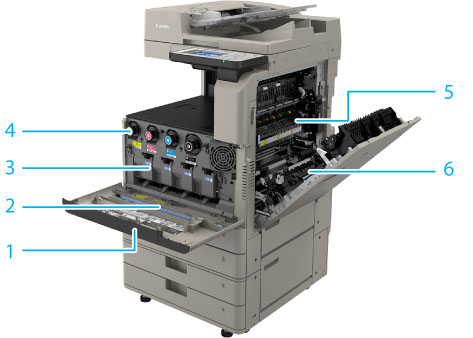
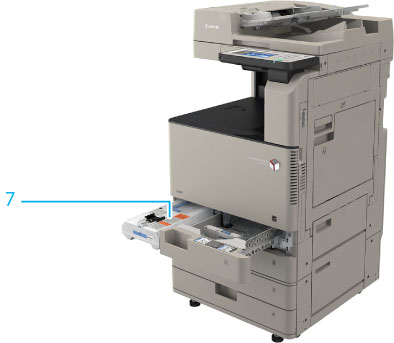
|
1.
|
Front Cover of the Main Unit
Open this cover to replace the toner cartridge and the drum unit.
|
|
2.
|
Dust Proof Glass Cleaner
Use this cleaner when cleaning the dust proof glass.
|
|
3.
|
Drum Unit
The unit that sets toner onto paper. For instructions on replacing the drum unit, see "Replacing the Drum Unit."
|
|
4.
|
Toner Cartridge
When toner runs out, pull out the toner cartridge and replace it with a new one. (See "Consumables.")
|
|
5.
|
Fixing Assembly
The unit that fixes toner onto paper.
|
|
6.
|
Duplexing Unit
If paper is jammed in the duplexing unit, remove the paper jam. (See "Clearing Paper Jams/Staple Jams.")
|
|
7.
|
Waste Toner Container
When the waste toner container becomes full, replace it with a new one.(See "Replacing the Waste Toner Container.")
|
Envelope Feeder Attachment A
Use when loading envelopes in a paper drawer. The Envelope Feeder Attachment can be used with Paper Drawer 2. For information on attaching the Envelope Feeder Attachment, see "Loading Envelopes."
Envelope Feeder Attachment A
Used with Paper Drawer 2. Envelopes are loaded horizontally.

|
NOTE
|
||
|
Feeder

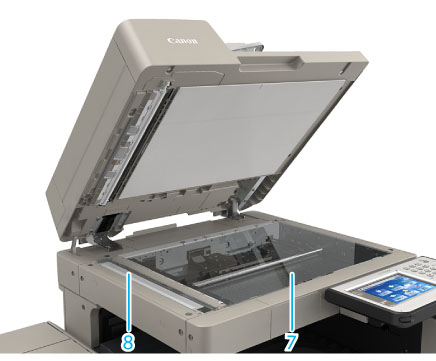
|
1.
|
Feeder Cover
Open this cover to remove jammed paper.
|
|
2.
|
Original Set Indicator
Lights when originals are placed in the original supply tray.
|
|
3.
|
Slide Guides
Adjust these guides to match the width of the original.
|
|
4.
|
Original Supply Tray
Originals placed here are automatically fed sheet by sheet into the feeder. Place originals into this tray with the surface that you want to scan face up.
|
|
5.
|
Original Output Area
Originals that have been scanned from the original supply tray are output into the original output area.
|
|
6.
|
Original Output Indicator
Lights up when originals are being output and flashes for a certain period after the originals have finished being output, to prevent the user from forgetting to take their originals.
|
|
7.
|
Platen Glass
Use the platen glass when scanning books, thick originals, thin originals, transparencies, etc.
|
|
8.
|
Document Feed Scanning Area
Scans documents sent from the feeder.
|
 CAUTION CAUTION |
|
Do not insert your fingers into the gaps around the original supply tray, as your fingers may get caught.
|
|
IMPORTANT
|
|
Be careful not to drop objects, such as paper clips into the gaps, as doing so may cause damage to the machine or cause it to break down.
When using the platen glass to copy or scan thick originals, such as books or magazines, do not press down hard on the feeder.
If the original output area is blocked, originals may get damaged, and printing may not be performed correctly. Therefore, do not place any objects in the original output area.
|
Control Panel Parts and Functions

|
1.
|
[Main Menu]
Press to display the Main Menu screen. If the Main Menu screen is not displayed when using a function, it is necessary to press [Main Menu] before using the function.
|
|
2.
|
Touch Panel Display
The settings screen for each function is shown on this display. Six function keys are displayed by default.
|
|
3.
|
Numeric keys
Press to enter numerical values.
|
|
4.
|
Energy Saver key
Press to set or cancel the Sleep mode. Lights when the machine enters the Sleep mode. For more information on the Auto Sleep mode, see "Main Power and Energy Saver Key." |
|
5.
|
Settings/Registration key
Press to specify settings/registration. |
|
6.
|
Counter Check key
Press to display the copy and print count totals on the touch panel display. |
|
7.
|
Clear key
Press to clear entered values or characters.
|
|
8.
|
Stop key
Press to stop a job in progress, such as a scan, copy, or fax (scanning only) job. |
|
9.
|
Start key
Press to start an operation. |
|
10.
|
Main Power Indicator
Lights when the main power is turned On. |
|
11.
|
Error Indicator
Flashes or lights if there is an error in the machine. When the Error indicator flashes, follow the instructions that appear on the touch panel display. When the Error indicator maintains a steady red light, contact your local authorized Canon dealer. |
|
12.
|
Processing/Data Indicator
Flashes or blinks green when the machine is performing operations, and maintains a steady green light when there is a job or received data waiting to be processed. However, if [Sleep Mode Energy Use] (Settings/Registration) is set to 'Low' and the machine is in the complete Sleep mode, the light will not turn on, even if the received data is stored in memory. (See "Energy Consumption in the Sleep Mode.") |
|
13.
|
Reset key
Press to restore the standard settings of the machine. |
|
14.
|
ID (Log In/Out) key
Press to log in/out when a login service such as User Authentication or DepartmentID Authentication has been set.
|
|
15.
|
Edit Pen
Use when operating the touch panel display, such as to enter characters.
|
|
16.
|
[Status Monitor/Cancel]
Press to check the status of jobs or to cancel print jobs. Also, you can check the status of the machine such as the amount of paper remaining in the paper source.
|
|
17.
|
[Dest./Fwd. Settings]
Press to register e-mail addresses and phone numbers, and set forwarding destinations for received documents.
|
|
18.
|
[Quick Menu]
Press to display functions registered in the Quick Menu.
|
|
19.
|
Brightness Adjustment Dial
Use to adjust the brightness of the touch panel display. |
|
20.
|
Volume Settings key
Press to display the screen for adjusting settings, such as the transmission volume and fax sending/receiving alarm volume. |
Adjusting the Angle of the Control Panel
The angle of the control panel is adjustable as shown below.
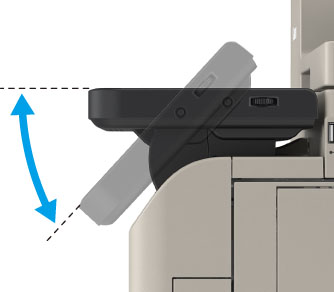
|
IMPORTANT
|
|
Do not apply excess force to the control panel when adjusting its angle.
|
|
NOTE
|
|
For more information on the optional products that can be attached to the machine, see "Optional Products/Software."
|
